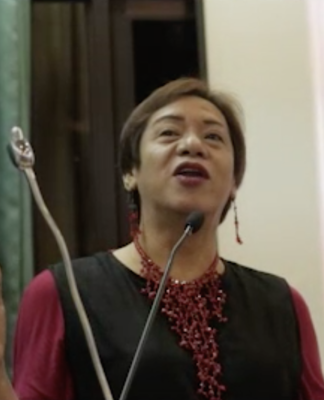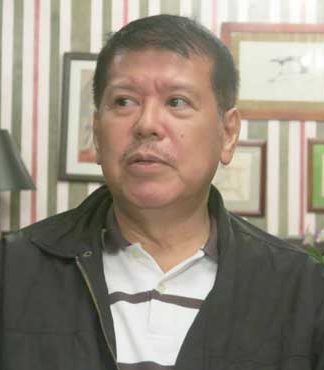During those turbulent times, students were at the frontlines of the mass movements against Marcos. Activism on campuses was at its peak and students were willing to give up much more than their studies for their beliefs.
Now president of the Akbayan Citizen Action Party and an advocate of progressive reform, Ronald Llamas had drafted the constitution that shaped the fundamental student political system in UST: the constitution of the Central Student Council (CSC). This was after the cosmetic lifting of Martial Law in 1981.
Llamas entered UST in 1978 and took up Journalism. He used his journalistic skills to go against the ultra-conservative administration in the university and voice out the student body’s concerns. He wrote for Hudyat, then the official newsletter of the Samahan ng mga Tomasino sa Pamamahayag (now the UST Journalism Society), The Flame, the official Artlets student paper, and the Varsitarian, where he was Features editor until 1981.
Llamas said press freedom was the least of their problems.
“Buhay noon ang harassment. Kahit hindi kami masyadong tinatamaan, alam namin nasa firing line kami. Mismo ‘yung administration ay nagagamit ng gobyerno para pigilan kami,” Llamas said.
So when the University tried to curtail the Varsitarian from publishing anti-government articles, Llamas was the first to resign from his position, encouraging other staff members to do the same.
Even though he had a scholarship and stipend from the Varsitarian, Llamas grew tired of the editorial intervention. Armed with a cardboard megaphone and political fervor, Llamas led student rallies on campus until the EDSA revolution. “Sa harap kami ng Main Building o ng (Commerce building) nagra-rally,” he recalled. “Kapag tinatakot kami ng UST administration, lalo kaming tumatapang. Point-counterpoint. Kapag tinataasan nila, tataasan rin namin.”
In 1981, there was a “partial lifting” of martial law. Marcos gave the press freedom to express their opinions. Intelligence agencies and the police couldn’t arrest media members without a warrant. But getting arrested by the police was the least in Llamas’ mind.
“Unofficial ‘yung mga killings. Kaaway mo ‘yung mga goons, military, at intelligence units,” Llamas said. “I was ambushed in 1983 on my way to a forum. I survived, but a friend who was with me died.”
In school, press freedom wasn’t the only thing Llamas wanted the administration to reconsider. There was also the educational system.
“We had a share of apathetic professors during our time,” Llamas said. “They were neither for nor against. I think during a crisis or during an upheaval they should teach us what we need to know. Not be indifferent.”
Instead of pursuing a Journalism career after college, he joined trade union movements and organized labor and sectional groups, educating then involving workers in the situation by bringing them to mass movements.
“We were preparing for a longer fight which could have been bloody,” he said.
Asked whether EDSA was a meaningful revolution, Llamas said yes and no. Yes, because it united the Filipino people against a dictator. “We were in the spotlight of the world because we overthrew one of the most popular, strongest and oldest dictatorships in the world—and we did that peacefully,” he said.
But the lessons of EDSA were also not impressed on the people.
“Tiniklop na lang natin ‘yung mga bandera at nag-uwian. Walang naparusahang human rights violator, walang naparusahang Marcos crony. We have no concept of shame or of honor.”
The old trapo, the old elite, came back. Now, Llamas sees that the fervor of the student mass movement has died down.
“In our time, you can distinctly see prominent leaders of student movements in the front lines. Now, they’re gone,” Llamas said. “They don’t want to get involved anymore, they’d rather stay inside their ‘comfort zones.’”
Llamas believes the generation today is too pre-occupied with TV and Internet and too jaded and made them apathetic about more important things.
Put it on paper
Prior to the historic events that led to the EDSA Revolution, the Varsitarian was reputed to be conservative. Many believed that the publication was tethered to the administration because the paper focused more on campus matters rather than tackling issues of national concern. This perception, however, changed after the assassination of Sen. Benigno “Ninoy” Aquino in Aug. 21, 1983. The Varsitarian, took a more vocal stand on social awareness and responsibility.
“We cut loose the chains of fear. It was the best time to be a writer, to be an activist,” said Dr. Julius Caesar Dalupang, then Circle section editor and later editor in chief.
The news section was then covering the usual UST events but the editorials and columns took on strong political tones. The paper freed column space for the philosophies of opposition figures like Salvador Laurel and Jose Burgos. Almost every article published was on social revolution and nationalism.
“The Circle section featured performing arts, visual arts, and books shouting with social conscience. The Witness section also became a vehicle for social liberation. Our Literary and Filipino sections departed from the idyllic and began spewing anger, frustrations, and hopelessness. I guess the only section that was apolitical then was the Sports section,” Dalupang said.
In 1981, Dalupang, a Biochemistry sophomore, was a news reporter for the Varsitarian. He later became Circle editor. He became editor in chief in his first year at the Faculty of Medicine and Surgery, from 1985 to 1986, during the height of the People Power Revolution.
Although he wrote articles critical of the government, his first actual display of indignation against the Marcos regime wasn’t until after Aquino’s death. He said he wanted to protect his objectivity as a writer and didn’t want to be identified with either party.
“But when Ninoy was assassinated, I marched along with millions of Filipinos during his funeral and again, during the snap elections, when I joined the ‘yellow’ brigade supporting Cory Aquino,” he said.
After hearing the late Jaime Cardinal Sin’s call for Filipinos to protect the renegade military forces led by Juan Ponce Enrile and Fidel Ramos, Dalupang dashed to EDSA and there became one of many witnesses to history then unfolding. He instructed his staff to stand vigil and they, along with thousands of Filipinos, spent the night praying and singing until the wake of Feb. 25, when it was announced that the Marcos family had left Malacañang. “We wept, we prayed, we laughed,” he said.
While some questioned the moves of this once-timid publication, like the university-wide mock elections Varsitarian held before the presidential snap-elections in 1986, Dalupang stood his ground and started redefining the role of Varsitarian during those turbulent times. He knew that the staff had to work hard to gain people’s respect .
He showed that the Varsitarian was “socially relevant, sensitive, and responsible without being labeled as a radical left-leaning school paper.”
At 43, Dr. Dalupang recalls these stories with enthusiasm and even if he is busy as specialist of respiratory medicine at the Capital Medical Center, he still has the passion for writing. He has been writing medical case studies and scientific articles for three years and served as editor in chief of their medical society’s newsletter.
Important lesson learned
In 1972, political science professor Jose David Lapuz was on his way to UST and he thought it was a “light day” because there was hardly any pedestrian on the streets. He saw members of the Police Constabulary managing the traffic along España Blvd., but he did not bother with their presence.
Upon entering St. Raymund’s Bldg, where he was teaching the Life and Works of Dr. Jose Rizal, International Relations, Philippine Government and Constitution, and other subjects, he read on the Faculty of Arts and Letters blackboard that Sen. Benigno Aquino Jr. had been arrested. He knew something was wrong.
Not having paid attention to the news the night before, he turned his radio on and heard the voices of former Sen. Francisco Tatad and Marcos repeatedly saying that Martial Law had indeed been declared.
“There was no newspaper in sight except the Daily Express, the only one allowed to herald the news about the declaration. All our rights were put on hold,” Lapuz said.
However, Proclamation 1081, which put the country under Martial Law, had done no harm to Lapuz’s desire to educate Thomasians. He said he believed in the late Pope John Paul II’s maxim to “be not afraid.”
“I did not worry about martial law. It was my duty to go on lecturing,” Lapuz said. But he and other professors were more cautious especially in their language lest they might be mistaken for going against the government.
Lapuz never lectured on the forcible overthrow of the constituted government because that would have been illegal. He never told his students to go out and rally on the streets. Instead, what he did was to “elucidate, explain, and make plain the terrible and difficult issues of our time.”
Two decades ago, the whole country made a forceful yet peaceful move to depose dictatorship through a historic people power revolution in EDSA.
“It was cold, like spring time and it was full of the images of the Virgin Mary, Jesus Christ, Sto. Niño all over Edsa,” recalled Lapuz. He said the people were praying, singing, then praying again, and ready for the arrival of military tanks.
When a tank came, the nuns and other women would border it until it halted. They then would tell the soldiers, “kapatid, magkaisa tayo.”
“The soldiers would come out of the tanks crying and take the bread the women offered,” he said.
He is not a religious man, he says, but in those cold days of February 1986, he was praying all the prayers he had memorized from catechism. “I suddenly became a very religious man,” Lapuz said. “How could we lose when God was on our side?”
Former Pres. Corazon Aquino, the late Jaime Cardinal Sin, the nuns, the professors, students and all the people in EDSA, went to war with God’s benediction. There were no classes in the University because nobody was present in school. Teachers and students were in EDSA, so in a way, it became an extension of UST.
One student jokingly said, “Sir, we are not in UST!” to which Lapuz replied, “that is what you think.” Lapuz still handled classes during those times, only, his students were on the streets instead of the classroom—fighting a real enemy and desiring a real democracy.
Two decades after the victory of the EDSA Revolution, Lapuz still lectures on the life and works of Rizal, on justice, on human rights, on liberty, and on democracy. He still tells students that “no dictator rises without our consent, no dictator lasts without our consent.”














